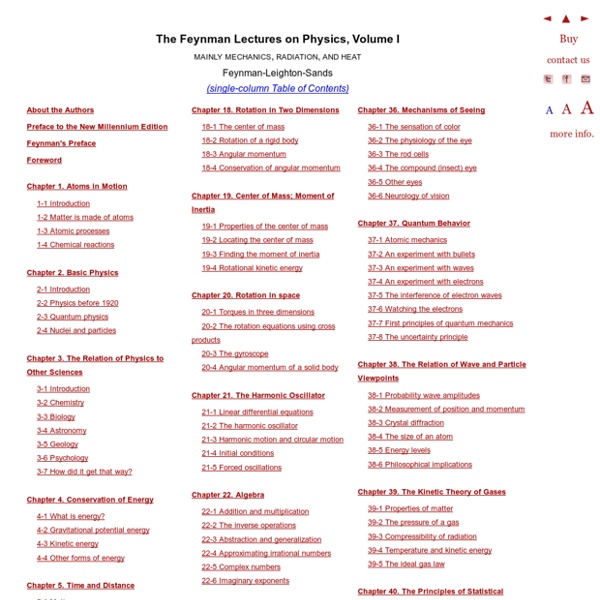



http://www.feynmanlectures.caltech.edu/I_toc.html
How Science Turned a Struggling Pro Skier Into an Olympic Medal Contender - Wired Science Saslong.org/R.Perathoner Steven Nyman is poised at the starting gate, alert, coiled, ready. A signal sounds: three even tones followed by a single, more urgent pitch, sending Nyman kicking onto the Val Gardena downhill ski course. He pushes five times with his poles, accelerating as quickly as possible, stabbing the snow frantically. He skates forward with abbreviated strokes, neon green boots moving up and down, his focus on building as much momentum as possible.
Math, Physics, and Engineering Applets Oscillations and Waves Acoustics Signal Processing Electricity and Magnetism: Statics Beautiful Mathematical GIFs Will Mesmerize You Digital artist and physics PhD student Dave Whyte is dazzling our computer screens with his mesmerizing GIFs that are the perfect marriage of mathematics and art. And we can’t stop watching them. Whyte shares his brilliant, procrastination-fueling creations on an almost daily basis on his Tumblr account, Bees & Bombs. Whyte studies the physics of foam and told Colossal that his first geometric GIFs riffed on computational modules that he was exploring as an undergraduate student.
Edward Witten Edward Witten (/ˈwɪtən/; born August 26, 1951) is an American theoretical physicist and professor of mathematical physics at the Institute for Advanced Study in Princeton, New Jersey. Witten is a researcher in string theory, quantum gravity, supersymmetric quantum field theories, and other areas of mathematical physics. Birth and education[edit] Witten was born in Baltimore, Maryland. Einstein for Everyone Einstein for Everyone Nullarbor Press 2007revisions 2008, 2010, 2011, 2012, 2013 Copyright 2007, 2008, 2010, 2011, 2012, 2013 John D. Norton Published by Nullarbor Press, 500 Fifth Avenue, Pittsburgh, Pennsylvania 15260 with offices in Liberty Ave., Pittsburgh, Pennsylvania, 15222 The bacteria that turns water into ice Meet Pseudomonas syringae, a bacterium that causes disease in plants and helps make snow machines work. It all has to do with ice nucleation — the process that forms ice crystals in the atmosphere and, thus, snow. You probably know that raindrops and snowflakes form around something. There's always a central nucleus that serves as the backbone of the water molecule structure. Usually, when people talk about this process, they use soot or some other kind of particulate matter as the example of what a nucleus can be.
Charles Darwin Charles Robert Darwin, FRS (/ˈdɑrwɪn/;[1] 12 February 1809 – 19 April 1882) was an English naturalist and geologist,[2] best known for his contributions to evolutionary theory.[I] He established that all species of life have descended over time from common ancestors,[3] and in a joint publication with Alfred Russel Wallace introduced his scientific theory that this branching pattern of evolution resulted from a process that he called natural selection, in which the struggle for existence has a similar effect to the artificial selection involved in selective breeding.[4] Darwin published his theory of evolution with compelling evidence in his 1859 book On the Origin of Species, overcoming scientific rejection of earlier concepts of transmutation of species.[5][6] By the 1870s the scientific community and much of the general public had accepted evolution as a fact.
100 Incredible Lectures from the World's Top Scientists Posted on Thursday June 18, 2009 by Staff Writers By Sarah Russel Unless you’re enrolled at one of the best online colleges or are an elite member of the science and engineering inner circle, you’re probably left out of most of the exciting research explored by the world’s greatest scientists. But thanks to the Internet and the generosity of many universities and online colleges, you’ve now got access to the cutting edge theories and projects that are changing the world in this list below. Is the Universe a Simulation? Photo Gray Matter By EDWARD FRENKEL IN Mikhail Bulgakov’s novel “The Master and Margarita,” the protagonist, a writer, burns a manuscript in a moment of despair, only to find out later from the Devil that “manuscripts don’t burn.” While you might appreciate this romantic sentiment, there is of course no reason to think that it is true.
Rap News 28: The Singularity Today we travel into the pure world of sci-fi to investigate the much vaunted, mysterious potential future event known as 'The Singularity'. What will a machine consciousness mean for humanity? What are the ethical, political, military and philosophical implications of strong A.I.? And what would an AI sound like when spitting rhymes over a dope beat?